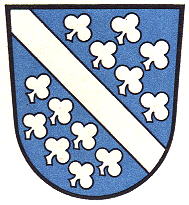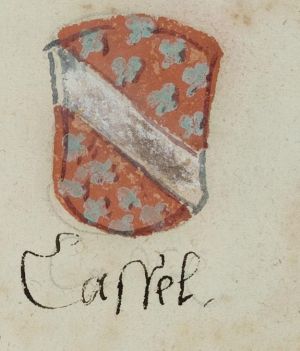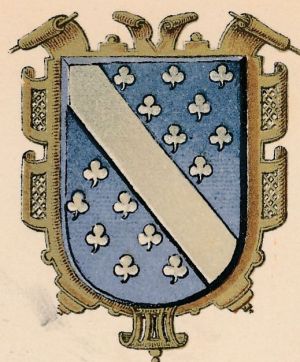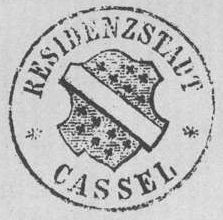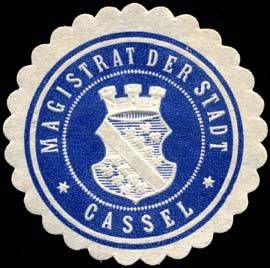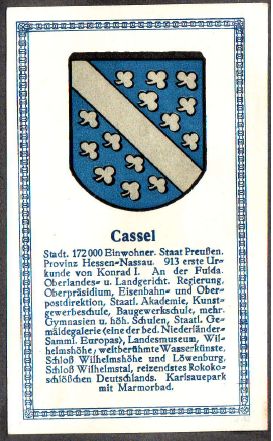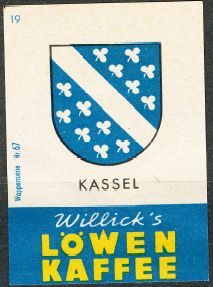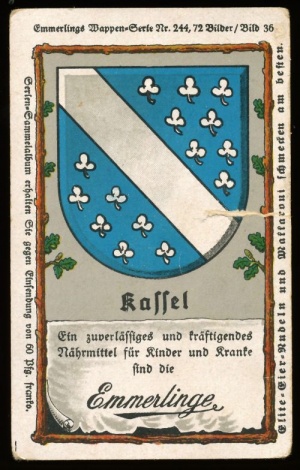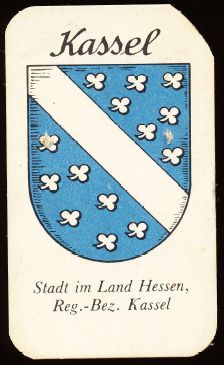Kassel: Difference between revisions
Knorrepoes (talk | contribs) m (Text replacement - "{{de}} '''" to "{{de}} '''") |
Knorrepoes (talk | contribs) m (Text replacement - "===Origin/meaning=== The" to "===Origin/meaning=== The") |
||
| Line 21: | Line 21: | ||
===Origin/meaning=== | ===Origin/meaning=== | ||
The arms were granted again in 1936, when the number of trefoils was set on 13. The arms of Kassel with the bar and the trefoils is known since the end of the 15<sup>th</sup> century. The trefoil appears for the first time on a seal dating from 1243. The seal shows a fortress with a church. On the middle tower of the church a trefoil can be seen. Around 1350 trefoil appear on watermarks of the city and finally in a seal in 1467 as the sole symbol. The origin of the trefoil is still unknown. Kassel became a city around 1225 and the oldest seals show Count Hermann of Thüringen, shown as a knight. There is no sign of a trefoil. | The arms were granted again in 1936, when the number of trefoils was set on 13. The arms of Kassel with the bar and the trefoils is known since the end of the 15<sup>th</sup> century. The trefoil appears for the first time on a seal dating from 1243. The seal shows a fortress with a church. On the middle tower of the church a trefoil can be seen. Around 1350 trefoil appear on watermarks of the city and finally in a seal in 1467 as the sole symbol. The origin of the trefoil is still unknown. Kassel became a city around 1225 and the oldest seals show Count Hermann of Thüringen, shown as a knight. There is no sign of a trefoil. | ||
Revision as of 09:37, 18 July 2022
This page is part of the German heraldry portal Deutsche Wappensammlung |
Heraldry of the World |
|
German heraldry:
|
Selected collector's items from Germany:
|
KASSEL
State : Hessen
Urban district (Kreisfreie Stadt) : Kassel
Additions : 1899 Wehlheiden; 1906 Bettenhausen, Kirchditmold, Rothenditmold, Wahlershausen; 1936 Harleshausen, Niederzwehren, Nordshausen, Oberzwehren, Wolfsanger, Waldau
| German |
Im blauen Schild ein silberner Schrägbalken, begleitet oben von sechs, unten von sieben schräggestellten silbernen Kleeblättern. |
| English | No blazon/translation known. Please click here to send your (heraldic !) blazon or translation |
Origin/meaning
The arms were granted again in 1936, when the number of trefoils was set on 13. The arms of Kassel with the bar and the trefoils is known since the end of the 15th century. The trefoil appears for the first time on a seal dating from 1243. The seal shows a fortress with a church. On the middle tower of the church a trefoil can be seen. Around 1350 trefoil appear on watermarks of the city and finally in a seal in 1467 as the sole symbol. The origin of the trefoil is still unknown. Kassel became a city around 1225 and the oldest seals show Count Hermann of Thüringen, shown as a knight. There is no sign of a trefoil.
| The arms in a 16th century manuscript |
The arms in a manuscript from +/- 1730 |
| The arms in an 1884 book |
The municipal stamp shown in 1892 |
| The arms in a German album +/- 1910 |
Seal from around 1900 |
| The arms by Hupp in the Kaffee Hag albums +/- 1925 |
The arms in the Abdulla album, 1928 |
| The arms on a 1960s matchox label |
The arms on a 1910s trade card |
| The arms on a 1960s trade card |
The arms in the Abadie albums |
| Postal cancellation 1961 |
The arms on the city hall (image Hubert de Vries) |
Contact and Support
Partners:
Your logo here ?
Contact us
© since 1995, Heraldry of the World, Ralf Hartemink 
Index of the site
Literature : Stadler, 1964-1971, 8 volumes.


